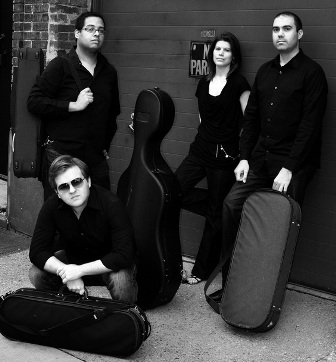
Frequency Quartet Brings Reich's Masterwork to the Freedom Center

Frequency String Quartet. L to R: Joshua Ulrich (seated), Michael Jorgensen, Amy Gillinghham, Dominic DeStefano
|
You don’t have to remember train travel to be mesmerized by Steve Reich’s “Different Trains.”
All you have to do is listen to the music, which, in the style of American minimalism, pulses irresistibly from beginning to end.
But it is more than that. It is a musical documentary of the Holocaust.
Composed for the Kronos Quartet in 1988, Reich’s masterpiece was the featured work on a concert by the Frequency String Quartet Tuesday evening in Harriet Tubman Theater at the National Underground Railroad Freedom Center.
The newly formed ensemble – violinists Michael Jorgensen and Joshua Ulrich, violist Dominic DeStefano and cellist Amy Gillingham – saluted Jewish-American Heritage Month with a program that also included works by Dmitri Shostakovich and Viktor Ullmann. Ullmann, a victim of the Holocaust, wrote his String Quartet No. 3 at Theresienstadt, the Nazi “showcase” concentration camp, in 1943. Shostakovich, who labored in the Soviet Union (always in danger of censure or worse), wrote his String Quartet No. 1 on the cusp of World War II in 1938.
Co-sponsored by the Freedom Center and the Center for Holocaust and Humanity Education, it was a searing program complete with explanatory video and narration by the performers.
Reich, a Jewish-American who turns 75 this year, was inspired to write “Different Trains” by his experience from 1939-41, traveling between the East and West Coasts to spend time with his divorced parents. How different, he thought, was the experience of Jewish children living in Europe, who at the same time, were being transported to Nazi death camps in cattle cars.
The three-part work is set for amplified string quartet (the quartet was outfitted with microphones) and pre-recorded tape. To make the tape, which uses three different string quartets and is played back against a live quartet, Reich took speech samples from the governess who traveled with him, a retired Pullman porter and three Holocaust survivors and combined them with American and European train sounds of the 1930s and 40s.
The pitches of the voices were created using a digital sampling keyboard. The women’s voices are imitated by the viola, the men’s voices by the cello. Everything is clothed in music, even the train whistles, which were enhanced by the Frequency Quartet members playing close to the bridges of their instruments.
The work is in three parts: “America -- before the war,” “Europe -- during the war” and “After the war.” There is an emotional arc to it. The central portion is filled with shrieking whistles and speech fragments (“Don’t breathe,” “Loaded with people,” etc.). This was in shocking contrast to the first part, a child’s experience of traveling “from New York to Los Angeles” on “one of the fastest trains,” and part three with its recollections of “going to America” and of those left behind.
All of this made for compelling listening and a musical experience not soon to be forgotten.
The concert began with Shostakovich’s String Quartet No. 1, a work that belies its surface impression. Like his Symphony No. 5, it was written in reaction to Soviet dictator Josef Stalin’s furious criticism of his opera “Lady Macbeth of Mtsensk” -- and the straits such “formalist,” i.e. “difficult,” music might get him into. Ulrich played first violin here, producing a lovely, smooth sound, taken up by violist DeStefano in an extended solo in the second movement. The emphasis was on lyricism, with a bright Allegro finale that, like Shostakovich’s Fifth Symphony, had a touch of the mock heroic.
The quartet played the first three movements of Ullmann’s String Quartet No. 3 (omitting the Allegro vivace finale). As such, it ended on a somber, unresolved note, much like his tragically short life (Ullmann died at Auschwitz in 1944 at age 46). It was requested that there be no applause.
Jorgensen on first violin gave the opening theme a gentle, nostalgic tug, an effect intensified upon its repeat at the end of the upbeat Presto. The concluding Largo trailed softly upward at the end, like a search unfulfilled.
The mission of the Frequency String Quartet is new music. Ulrich, DeStefano and Gillingham all have degrees from the University of Cincinnati College-Conservatory of Music, where Ulrich is currently pursuing his doctorate and DeStefano is a member of the viola faculty. Gillingham, formerly on the theory faculty at CCM, teaches at Indiana Wesleyan University. Jorgensen is a graduate of the Eastman School of Music and the Guildhall School of Music and Drama in London, with a doctorate from Florida State University. All are residents of Cincinnati.
One looks forward to more from this gifted and stimulating ensemble. For further information, visit www.frequencystringquartet.com